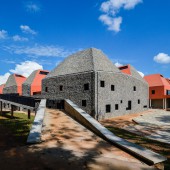Faculty Architecture Education School by Patrick Schweitzer S&AA |
Home > Winners > #104880 |
 |
|
||||
| DESIGN DETAILS | |||||
| DESIGN NAME: Faculty Architecture PRIMARY FUNCTION: Education School INSPIRATION: The building uses two simple materials commonly found in the region: stone for the exterior envelope; and self-coloured concrete for the interior. The building has small outward-facing windows and large inward-facing windows protected from the sun by roof overhangs. The upper section of the pyramids is truncated in order to bring in natural light and optimise ventilation. UNIQUE PROPERTIES / PROJECT DESCRIPTION: The firm responded to an international call for tender launched in March 2012 by the government of Rwanda for the design of a new architecture school to accommodate 600 students on a 5,600 sq.m. site not far from the existing faculty. For this project we began with a simple form on two levels which we distorted in the same way tectonic forces distort land masses: we pulled on opposite sides, making a gap in the centre that would form the outside area for the students. OPERATION / FLOW / INTERACTION: The firm responded to an international call for tender launched in March 2012 by the government of Rwanda for the design of a new architecture school to accommodate 600 students on a 5,600 sq.m. site not far from the existing faculty. PROJECT DURATION AND LOCATION: Kigali at Rwanda 2017 to 2018 FITS BEST INTO CATEGORY: Architecture, Building and Structure Design |
PRODUCTION / REALIZATION TECHNOLOGY: The building uses two simple materials commonly found in the region: stone for the exterior envelope; and self-coloured concrete for the interior. The building has small outward-facing windows and large inward-facing windows protected from the sun by roof overhangs. SPECIFICATIONS / TECHNICAL PROPERTIES: The project does 5 600 square metres TAGS: Rwanda, school, architecture, Kigali RESEARCH ABSTRACT: The firm opted for a highly architectural project using complex forms, driven by both pedagogical and environmental concerns, halfway between traditional architecture and contemporary design. This is a simple, didactic building designed to train the future architects of a developing African country whose population is set to double by 2050. CHALLENGE: The difficulty of the project was to manage it from France, with a relay on site and to use only local materials. ADDED DATE: 2020-04-01 13:29:34 TEAM MEMBERS (5) : Architect of record : SetAA, Associate architect : EAACON, Construction : EGIS, Entreprise : CATIC and Landscape architect : Acte 2 paysage IMAGE CREDITS: Photo : Edwin SEda, Emmanuel Cattier, Jules Toulet |
||||
| Visit the following page to learn more: http://bit.ly/2WWVmIh | |||||
| AWARD DETAILS | |
 |
Faculty Architecture Education School by Patrick Schweitzer S&aa is Winner in Architecture, Building and Structure Design Category, 2019 - 2020.· Read the interview with designer Patrick Schweitzer S&AA for design Faculty Architecture here.· Press Members: Login or Register to request an exclusive interview with Patrick Schweitzer S&AA. · Click here to register inorder to view the profile and other works by Patrick Schweitzer S&AA. |
| SOCIAL |
| + Add to Likes / Favorites | Send to My Email | Comment | Testimonials | View Press-Release | Press Kit |
Did you like Patrick Schweitzer S&aa's Architecture Design?
You will most likely enjoy other award winning architecture design as well.
Click here to view more Award Winning Architecture Design.








